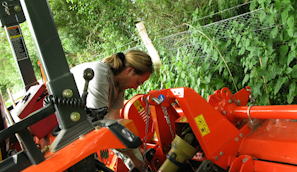~ Seed for CUCUMBERS ~
We prefer real vegetables that actually taste of something - not like the supermarket varieties. So we only offer particularly good cucumbers, and ones that are simple to grow. You can grow these inside or outdoors. But plants under cover will always fruit more heavily, and start cropping earlier in the season.
These real open-pollinated cucumbers are much easier and less fussy than the hybrids. You don't need to pick the male flowers off, and they don't go bitter if you grow several types. . .basically just plant them and let them get on with it. And of course if you wait long enough, you will get seeds in your cucumbers that you can grow next year!
Start the seed off somewhere warm in a small pot from late April (mid May if you're going to grow them on outside) and plant them out once they have 3 to 4 true leaves.
Small screen: Turn your device sideways to view sowing calendar.






















































 = normal sowing & harvest time
= normal sowing & harvest time![]()
 = also possible depending on conditions
= also possible depending on conditions
~ REAL CUCUMBERS ~

'Wautoma'
An excellent cucumber from the breeding program at the University of Wisconsin in the 1980's, this was recommended to us by cucumber expert Robert Bruns. It can either be used small for pickles or left to grow for use as a slicing cucumber. The plants set many lightly striped dark green fruit , with tiny white spines that come off easily. We got an awful lot of cucumbers off this one!
Quick to set fruit, bitter-free, and Robert says it resists nearly all known cucumber diseases. (anthracnose, angular leaf spot, CMV, DM, PM, & scab!)You can grow it indoors or out, and we think it'll be quite a few years before we find anything that can even come near it in terms of yield or reliability. We grow huge numbers outdoors here in Wales with no trouble at all.
Provide some support outdoors, under cover quite happy on the ground or can be trained up netting to save space.
 10 seed, organic
£
10 seed, organic
£
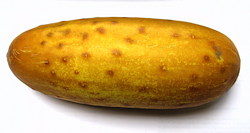
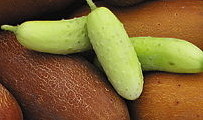
Poona Kheera (Lime green, then Orange)
This new cucumber from India is very good, and more than a little different from any others we have ever seen.
Firstly, it is very, very crisp and crunchy - even for a cucumber! It is hard to explain, but when you try it you will understand - it is particularly crisp (in a nice way).
And secondly, it is incredibly colourful: it starts out a very bright lime green (that picture has not been enhanced!), but as it gets bigger, it turns an amazing orange colour.
It is good eating at all stages.
 14 seed
£
14 seed
£
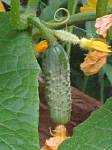
'Parisian Pickling'
A proper gherkin-type cucumber with a long history - selected in the 1800's for the cooler northern climate of Paris when cucumbers became fashionable in the city - other 'southern types' just couldn't crop reliably that far north.
It is a very reliable early cucumber, making lots of fruit with no fuss, even in the UK. It used to be grown as a pickling cucumber - but it also works well letting it get bigger for use in salads.
This a good choice if you only have room for one type of cucumber, but want pickles as well as salad.
![]() 25 seed £
25 seed £
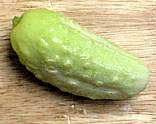
'Miniature White'
These fantastic little yellow-white cucumbers are Ben's favourite. Best picked when about 2" long, and terrific in salads. They have very soft thin skin, without any bitterness, and distinctly sweet crunchy flesh.
We know a lot of people with smaller families also like this variety because they can use a whole cucumber in a salad, and not be left with half cukes in the fridge.
The vines are very compact, start to bear early, and happily climb netting, or grow on the ground. Can't be beaten!
Sweet, pretty colour. Crunchy!
 15 seed
£
15 seed
£
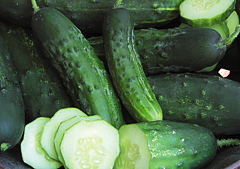
'Early Fortune'
An early and prolific heirloom dark green cucumber. This variety was bred around 1900 by a farmer called George Starr , who was growing a field of the cucumber ‘Davis Perfect’( which is now sadly extinct) to sell at market.
In that field he found just one much earlier and better plant that really stood out from the rest. He saved seed from that one special plant and from those he selected this new variety which he named ‘Early Fortune’.
It was then introduced commercially for small market gardeners and home gardeners by the “Jerome B. Rice Seed Co” in 1910, and has been popular ever since, as it starts to make fruit really quite early in the season.
 14 seed
£
14 seed
£
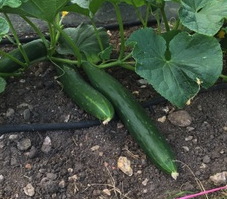
'Eden's Burpless Tasty Green' NEW IN 2023
We are excited to bring you a small number of packets of this, maintained and improved over the years by plant breeder Eden Weiss at St. Giles' Farm in the New Forest. His partner Claudia got in touch asking if we would like to offer it, explaining:
"...Eden has also worked for many years with the ridge cucumber ‘Burpless Tasty Green’ and has made positive seed selections from it, which in our opinion has led to the original cucumber becoming adapted to our site, surpassing the original in taste ..."
It's a ridge cucumber, but is adapted to growing outdoor under cloches as well as in a tunnel or greenhouse. Do let us know what you think of it!
 10 seed
£
10 seed
£
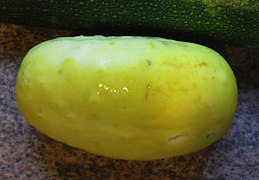
'Boothby's Blond' YELLOW, LUNCHBOX CUCUMBER
This new variety is an early-cropping heirloom from the Boothby family in Maine.
It makes sweet crisp fruit, best taken when about 4 inches long, and comes from a region with cold springs and a short growing season, so it is well adapted to setting fruit pretty quickly.
It does really well for us and we like it because the fruit ripen to an amazing bright yellow colour while still being good to eat, and they are the perfect size to slip into a lunchbox for a refreshing snack.
Really good flavour. Children like to eat them for snacks!
 16 seed
£
16 seed
£
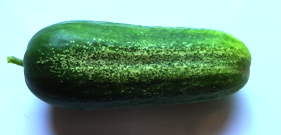
Siberian Podarok
These cucumbers are about 4 - 5 inches long, and a bright kermit green with many small white spines that rub off fairly easily.
Originally bred as a pickling gherkin type, but we find it actually very nice raw as a salad cucumber. It is from Siberia and did well for us outdoors in Wales.
Originally from Andrei Barawovski in the Ukraine. Just a few packets this year.
 12 seed
£
12 seed
£
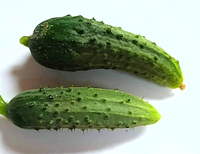
Salty Ears (Pickling Only)
An unusual cucumber, definitely only for pickling, as it is not juicy. This is so that it remains firm and pleasingly crunchy when boiled and bottled.
This works very well as long as you are not expecting a salad cucumber! Sent to us by Andrei Barawovski.Pick small and pickle using your favourite pickled gherkin recipe.
 14 seed
£
14 seed
£
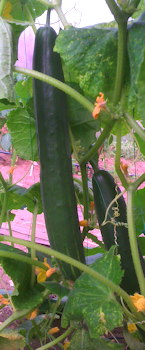
'Gergana'
This was a very exciting find a few years back, a traditional variety we got from Bulgaria, that was said to be good for early cropping and home growing.
And it lived up to its reputation! We got very quick-growing plants that soon set large numbers of impressively long (30cm +), slightly ridged green cucumbers. In fact we have had to put up extra netting to contain it, as it was trying to take over our polytunnel!
 10 seed, organic
£
10 seed, organic
£

'Tamra'
This superb variety was thought lost years ago, but cucumber breeder Robert Bruns heard of our search for an early, disease resistant, non-bitter, cucumber, and sent us the last few seeds he had. From those few seeds we regenerated this variety back in 2002 - & it's great!
Everyone who has tried it loves it. But because it makes very few seeds, we simply couldn't manage to keep it in the catalogue, and a few years ago we stopped listing it.
However Alan Fryer had been so impressed by it that when he heard we'd dropped it he got in touch. After hearing the problem, he decided to take it on as a project - and produced seed for us for the next ten years, so thanks to his heroic efforts we were once again able to offer this terrific cucumber. Although he's had to stop growing, we've now managed to make space and aim to produce it regularly.
Consider saving your own seed. Cucumber seedsaving is easy and there are free instructions in our 'how to save seed' link to the left of this page.
 10 seed, organic
£
10 seed, organic
£
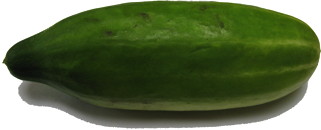
Chengelkoy
This delicious variety comes originally from Turkey. A traditional salad cucumber - it has a smooth, tender thin green skin with no bitterness and is very prolific. It grew all over our tunnel and made loads of fruit!
Very popular traditional variety, does well in the UK.
 10 seed
£
10 seed
£
~ Some other INTERESTING and TASTY THINGS from the CUCUMBER FAMILY

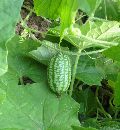
Melothrie (aka Cucamelon)
We are pleased to be able to offer another unusual cucumber relative given to us many years ago by Bruno Ansker from France. It's a rampant scrambling vine covered in hundreds of little green & white fruit about an inch long. Very, very easy to grow and great fun.
Here you can see them growing up a bit of netting in the polytunnel of our seed grower, Melissa Holloway. They are fairly unfussy - can get to about 7 or even 8 ft high in a good summer, but they'll also grow over lower netting if that's all you have.
These little fruit taste just like a cucumber and have a nice fresh crunchy texture. They're great for pickles, stirfry, & they look really good whole in salads. Everyone who tries them thinks they're great!
We like to put out a bowl of them (whole) for nibbles at parties, or try them halved as the perfect garnish for a G&T.
Grow outdoors in a sunny spot, or will really take off under cover .
 12 seed £
12 seed £
Note: This is one of these plants that still need their scientific classification sorted out. Some people say it should be called Melothria scabra, others think it is better called Apodanthera pringlei. Actually, the whole classification of this branch of the cucurbits is a bit vague - and one day no doubt some specialist somewhere (with more time than us!) will get enthusiastic enough to grow them all next to each other and sort it all out.
~ Various ACHOCHA ~
We like searching for interesting things to grow that are good to eat too. Achocha is one of these - an unusual vegetable from South America that is remarkably easy to grow. It is impressively productive, loves our variable UK summers, and can be used raw in salads when small a bit like a cucumber.
We have tried out lots of different achocha from seedbanks and private collections, and after much consideration, offer three varieties that we really love. "Fat Baby" is very early, and the easiest to grow outdoors. Giant Bolivian is a new addition, and has to be one of our favourite new finds in the last few years. The exploding cucumber is just for fun, but it tastes great too.

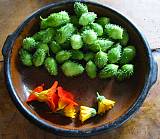
'Fat Baby'
Fat Baby is remarkably easy to grow, and can be used raw in salads when small a bit like a cucumber.
It is a quick and vigorous climber and you can climb it up and over anything, including garden sheds, although it does need a sunny open spot. Definitely best outdoors though and not in a polytunnel, because it tends to take over if grown inside.
The best thing however, is that the mature fruit taste very much like green peppers when fried - yet they can be grown outdoors with ease and set masses of fruit with no effort.
To cook, simply cut open and flick out the seeds (saving
a few for future planting of course) and then slice and fry just as
a green pepper. Very similar taste to green peppers, just much easier
to grow! Here they are on a very popular pizza Kate made for a
dinner party (the tomato sauce is of course yellow - using Plum Lemon Tomato - just
for fun, the achochas are the green bits.)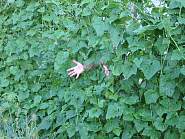
 8 seed organic
£
8 seed organic
£
For the pedantic, or botanically curious among you, the Latin name of this is said by many to be Cyclanthera pedata, but we are beginning to suspect it is actually Cyclanthera brachyastacha, as we think this is in fact a domesticated version of the Exploding Cucumber below. Not that it's terribly important, mind you.
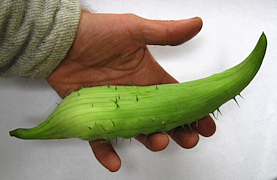
Giant Bolivian Achocha
We first read about Achocha in the wonderful book Lost Crops of the Incas many years ago.
In that book there was description of a huge Achocha, but although we grew many varieties over the years, we never found a really big one like it - until Ben tracked down seven seeds from a collector in Bolivia. The rambling plants grow huge fruit about 5 -6 inches long.
They are tasty both raw and cooked - very like sweet green peppers. And the huge vines yield lots of fruit. Amazing! Fried, or stuffed and roasted, it makes a great dinner.
It makes very few seeds, and we want as many people as possible to get a chance to grow this plant (we think its really great!). There are 5 seed in each packet, which should be plenty - if you do not get at least 2 big plants we will refund or replace!
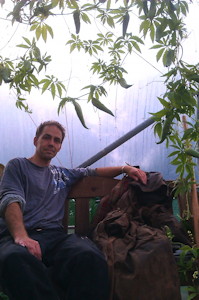
Ben chilling out in the tunnel with his Achocha . . .
'The Exploding Cucumber'
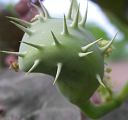 The
Fat Baby have always been a great hit both with us and everyone who
has tried them. So we were intrigued to find that they have a close
relative known as the Exploding Cucumber, whose Latin name is - quite
aptly - "Cyclanthera explodens".
The
Fat Baby have always been a great hit both with us and everyone who
has tried them. So we were intrigued to find that they have a close
relative known as the Exploding Cucumber, whose Latin name is - quite
aptly - "Cyclanthera explodens".
Anyways, these grow similarly to the Achocha - a tendrilly climbing vine . The fruit are similar, except having an even weirder shape, and when mature, they burst open at the slightest touch, flinging their seeds out across the garden!
Eating use is the same as Achocha; the fruit can be used small (1/2 inch) in salads or mature (1 inch, exploded) cooked. No need to deseed them first as they do this for you at the slightest provocation! They are of course also an excellent thing to enter in your local horticultural show for the 'unusually shaped vegetable' category.
|
HEALTH WARNING. We know this sounds silly, |
 10 seed, organic
£
10 seed, organic
£
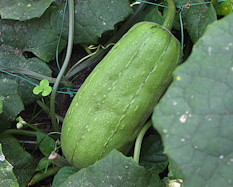
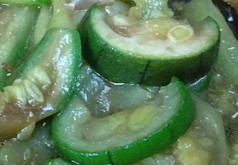
A climbing vegetable from Egypt, Vietnam and China, also spelt Luffa. It makes cylindrical fruit that are picked young and green (under 6 inches) and used fried, curried or boiled ( like a courgette), and has beautiful yellow flowers.
Grow up netting in a polytunnel or greenhouse only (it needs a long warm summer).
Delicious small, inedibly fibrous when large, but then can be used as a pot scourer - check your invoice sheet for instructions.
 12 seed
£
12 seed
£
Saving Cucumber Seed:
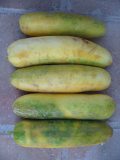
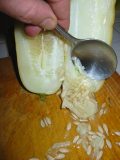
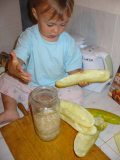
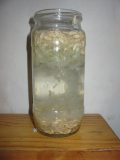
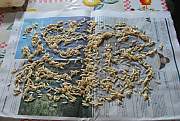
Here is Josie, aged 2, saving cucumber seed. It's really
simple.
Let them get over-ripe, scoop out the seeds, and put in jar with water
for a couple of days or so.
The good seeds sink and the bad ones float (being full
of air). Pour off the top 1/2 of the jar, losing the floating bad seed
and debris.
Refill & repeat a few times until you are left with just the good
heavy seed.
Then drain the good seeds through a sieve and onto a plate to dry, or onto a newspaper if the weather is cold and damp.
Then dry your seeds properly and store them safely away from heat and mice.
It is important that they haven't crossed with another variety. And of course you can only save the seed from real varieties, hybrids won't work.
Detailed seed-saving instructions are included with
your seeds,
and also in our freely-printable instruction sheets (which you can find in a box on the left hand side of this page)
so you can do this yourself.










